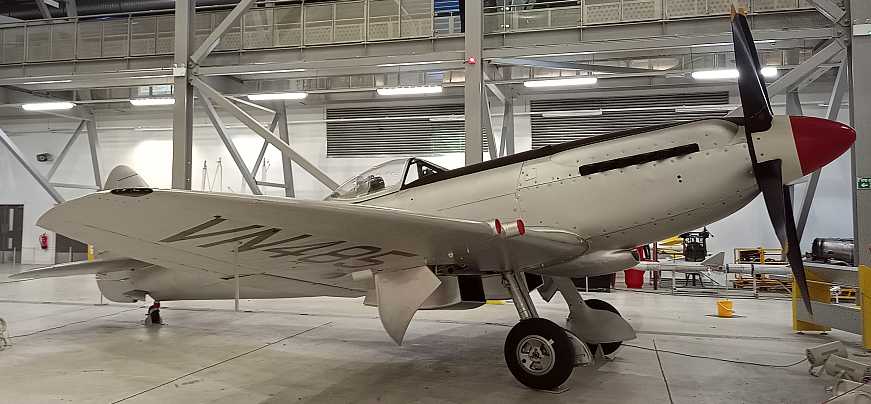Dinger's Aviation Pages
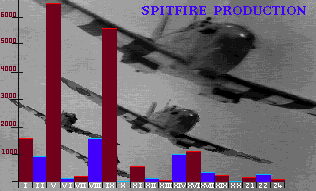
Graph of Spitfire production figures - Note the huge numbers of Mk V and IX produced
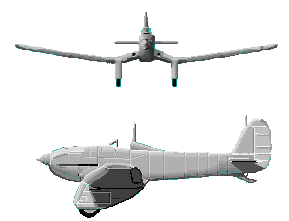
Supermarine Type 224.
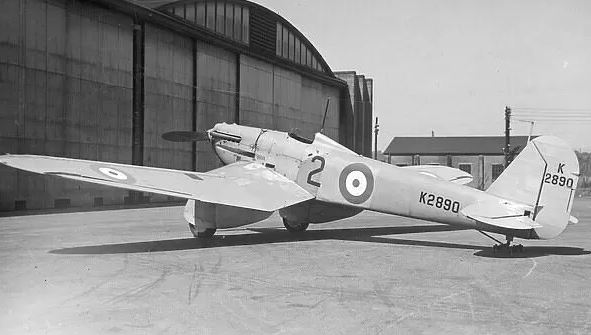
Built to Air Ministry Spec F7/30, this was the first aircraft to carry the name Spitfire. An inverted gull-winged monoplane with a fixed landing gear in "trouser" fairings, it was powered by a Rolls Royce Goshawk engine of some 600 horsepower and carried 4 machine guns. It first flew on the 19th February 1934. Its performance was disappointing, being less than that of the Gloster Gauntlet biplane fighter that was just about to enter service with the RAF. RJ Mitchell approached the Air Ministry to say he could do much better with a radical redesign incorporating a retracting undercarriage and flaps. Rather than give Supermarine more money for the F7/30 specification, the Air Ministry wrote a whole new specification (F37/34) around the new design - the Type 300.
SUPERMARINE TYPE 300 SPITFIRE PROTOTYPE.

Spitfire Prototype K5054 with fixed pitch two-bladed propeller and no exhaust stacks.
The Spitfire prototype, K5054, was first flown in March 1936. It was powered by one of the first Rolls-Royce Merlin engines. Early trials revealed a handling issue that was cured by reducing the size of the rudder horn balance. Top speed was at initially little disappointing, with only 330 mph achieved. Then it was realised that airflow over the fixed-pitch propeller was exceeding the speed of sound, leading to supersonic drag. When a redesigned propeller with a thinner blade was fitted, the top speed was boosted to 349 mph. Air Ministry Spec F37/34 had been written around the new type; even so, the new aircraft exceeded all expectations. In March 1937, the prototype did a wheels-up landing following an engine failure but was quickly repaired. The early Merlin "C" engine was later upgraded to an "F" engine, and then the Merlin II as used in the first production Spitfires. By September 1937, K5054 had been modified close to Mk I production standard. It was damaged during night-flying trials in March 1938, but again was swiftly repaired and then used for armament and gun-camera trials. It tragically overturned on landing on the 4th of September 1939, killing its pilot, Flt Lt G.S. White. The damaged airframe was retained at Farnborough throughout the war and used for experiments with fitting various photographic reconnaissance cameras.
SPITFIRE Mk I

Spitfire Mk I of 19 Squadron in early configuration, with a fixed-pitch two-blade propeller, straight top to the canopy, no armoured windscreen, "stick" radio mast and anti-flash guards protruding from the front of the wing-mounted machine guns.

Another Spitfire Mk I of 19 Squadron, this time in a later configuration with a three-bladed propeller, bulged cockpit canopy and tapered aerial mast. This Mk I (X4474) survived the Battle of Britain, later serving with 602 Squadron and different Operational Training Units (OTUs)

Another Spitfire Mk I of 19 Squadron, this time in a later configuration with a three-bladed propeller, bulged cockpit canopy and tapered aerial mast. This Mk I (X4474) survived the Battle of Britain, later serving with 602 Squadron and different Operational Training Units (OTUs)
The first production Spitfire, the first 170 or so early Mark I aircraft were initially fitted with the Merlin II engine, the rest were built with the Merlin III. Both versions of the Merlin produced 1,030 hp, giving the Spitfire Mk I a maximum speed of 367 mph, although in squadron service, with an armour plate for pilot protection added, the top speed was more likely to be 345 mph. The first batch had a straight-topped cockpit canopy, which was later changed for the bulged type. It was the Mk I that mostly fought in the Battle of Britain, (although some Mark II machines were in service from September 1940). Originally fitted only with wooden two-blade fixed-pitch propellers, they were later equipped with de Havilland three-bladed two-pitch airscrews. In June 1940, just before the Battle of Britain began these began to be swapped out for either Rotol or de Havilland constant-speed propellers which gave an increase in performance, cut down on the pilot's workload and reduced engine wear. Conversions of all Spitfires to constant-speed propellers were completed by mid-August 1940. Armament was either eight Browning .303 calibre machine guns (mk IA) or two 20 mm cannons (Mk IB). The cannon version was not produced in great quantity, the early cannon installations were not very satisfactory and prone to the mechanism jamming. The Spitfire I first entered service in 1938 with 19 and 66 Squadrons. In all, some 1,566 Mk I Spitfires were produced.
Mk I PR Conversions
There were various early modifications of the Mk 1 to the photo-reconnaissance role. Most conversions were carried out by the Heston Aircraft Company that shared the airfield where the first Spitfire photo-reconnaissance unit was based. The PR IA had armament removed and a camera in each wing. The PR IB had an extra fuel tank behind the pilot for a longer range and higher-resolution cameras in each wing. The PR IC improved range even more with a blister tank under the port wing balanced out by a blister containing the two cameras under the starboard wing. The PR ID had a fuel tank in the leading edge of each wing and the cameras installed in the fuselage, this mark needed significant development work and entered service after the others, being renamed the PR Mk IV in service. The single PR IE was for low-altitude missions with a camera under each wing angled out sideways. The PR IF had a fuel blister under both wings with an additional small tank under the pilot's seat. The two cameras were housed in the fuselage. It had a deeper nose for a larger oil tank and blisters in the cockpit canopy to give the pilot a better view. The PR IF was later renamed the PR Mk VI Then there was the PR IG, this was a low-altitude version that retained the full gun armament and armoured windscreen with blisters on the canopy sides to allow a better view for the pilot It had the additional fuel tank behind the pilot and space for two vertical cameras and one sideways-looking camera in the fuselage. It was the PR IG Spitfires that carried the famous pink camouflage scheme that worked very well when flying under cloud cover. The PR IG was later reclassified as the PR Mk VII.
SPEED SPITFIRE
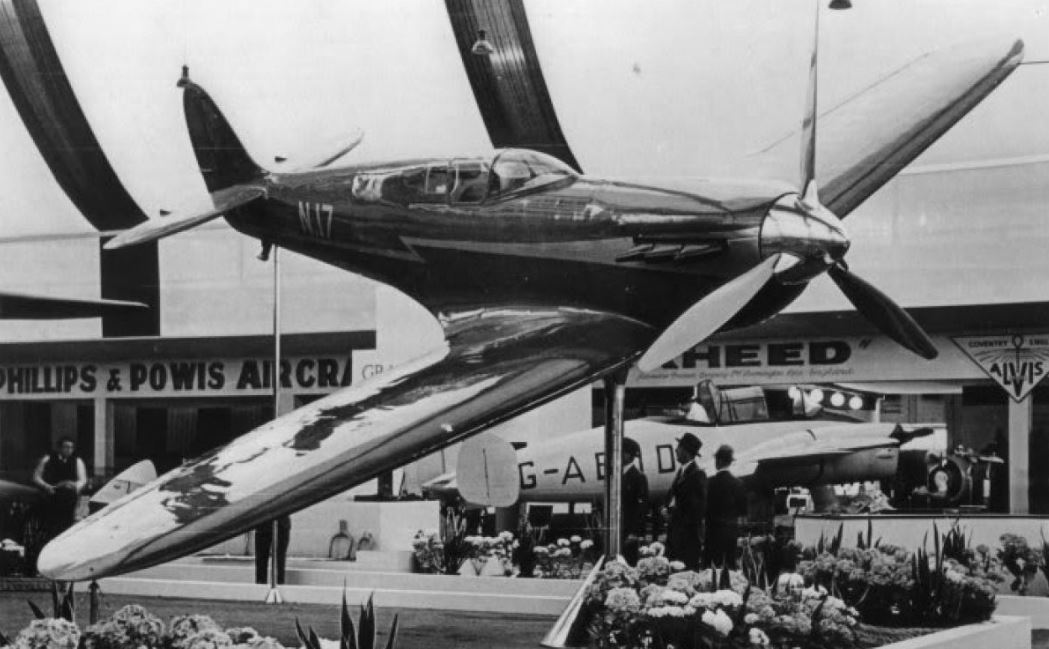
The "Speed Spitfire", as seen on display at the Brussels Aviation Salon in July 1939. On the stand behind it is the Reid and Sigrist R.S.1 Snargasher.
In an attempt to gain the world speed record two Mk I airframes on the production line were strengthened, one of these (K9834) was then fitted with a special "sprint" version of the Merlin II engine, shorter span wings and a long, streamlined cockpit canopy. The Heinkel 100 and Messerschmitt 209 put the record out of reach of the Speed Spitfire and it was fitted with a standard Merlin XII engine. There was an attempt to use it as a high-speed reconnaissance aircraft for which role it was fitted with an oblique camera in the fuselage. However, it had very small fuel capacity (only 60 gallons) and hence a short endurance (it was apparently only used on one photo-recce mission to Calais). It ended up being used as a runabout by the photo-reconnaissance unit at Heston. It survived until 1946.
SPITFIRE Mk II

Spitfire Mk II. Note the small teardrop blister behind the propeller, first introduced on the Mk II. This particular Mk II, P7290, was one of the first built and saw service with 611 Squadron during the Battle of Britain.

P7350 was another early Spitfire Mk II, it was shot down on the 25th October 1940. Its Polish pilot, Ludwik Martel, survived and went on to survive the war and settle in the UK. The Spitfire was repaired and returned to service. It still flies today with the Battle of Britain Memorial Flight. It is the only surviving airworthy Mk II. This photo shows it after it appeared in the 1969 film "Battle of Britain", wearing a much more glossy finish than it would have worn during WW2. It carries the "ZH" code of 266 Squadron, but that was not a code carried by 266 Squadron Spitfires during the Battle of Britain. The squadron used the code "UO" from 1940 through until June 1942, by which time it had replaced its Spitfires with Hawker Typhoons.

P7350 was another early Spitfire Mk II, it was shot down on the 25th October 1940. Its Polish pilot, Ludwik Martel, survived and went on to survive the war and settle in the UK. The Spitfire was repaired and returned to service. It still flies today with the Battle of Britain Memorial Flight. It is the only surviving airworthy Mk II. This photo shows it after it appeared in the 1969 film "Battle of Britain", wearing a much more glossy finish than it would have worn during WW2. It carries the "ZH" code of 266 Squadron, but that was not a code carried by 266 Squadron Spitfires during the Battle of Britain. The squadron used the code "UO" from 1940 through until June 1942, by which time it had replaced its Spitfires with Hawker Typhoons.
Produced at the Castle Bromwich "shadow" factory rather than at the Supermarine works at Southampton, production of the mark II had just got into full swing when the Supermarine works were badly damaged by bombing. The Mark II was powered by the slightly more powerful Merlin XII giving 1,175 hp increasing speed by some 10 mph. This may seem only a modest gain, but the Merlin XII used a glycol/water mixture under pressure for cooling rather than the unpressurised pure glycol system used on earlier Merlins. The new system removed heat from the engine more efficiently and made possible the later jumps in engine power of later Merlins. The armament was the same as the Mk I with different IIA (8 machine guns) and IIB versions (2 cannons and 4 machine guns). The only external difference between the Mk II and the earlier Mk I was a small teardrop-shaped blister on the starboard side of the nose of the Mk II that covered the Coffman starter gear that could be used to start the Merlin XII engine. Production was 750 Mk IIA and 170 Mk IIB. Some Mk IIs had a 40-gallon, non-jettisonable, fuel tank on the port wing for increased range, and classified as Mk II LR (for "Long Range"). The limited numbers produced saw extensive service during 1941, being passed from squadron to squadron as the need arose for longer duration missions. 50 Mk IIs were later converted to the Air-Sea Rescue role, equipped to search for downed airmen and drop small inflatable dinghies by parachute, along with smoke floats to guide rescuers. At first, this version was called the Mk IIc, but this conflicted with the later "type C" wing, an interim designation was "Sea Rescue Type E" before finally settling on "A.S.R. Mk II".
SPITFIRE Mk III

Spitfire Mk III, N3297, showing the reduced-span wing, retracting tailwheel and additional panels to cover the undercarriage recesses in flight.
Experimental prototype, extensively modified from a Mk I airframe (N3297) with a two-speed,1,280 hp Merlin XX engine and a retractable tail-wheel, shorter, blunter wings, a redesigned front windscreen and a slightly longer fuselage. The Mk III also had extra panels which fully covered the undercarriage when retracted (as per the Spitfire prototype). The Mk III was to be a new better breed of Spitfire. Because it was thought that the blunter wings would lead to it being confused with the German BF109, standard Spitfire wings were later fitted to the prototype and it was planned that a modified wing of standard shape with provision for cannons or machine guns (the so-called C-type "universal Wing") would be used on the production model. The Mk III seemed set for success, with massive orders being placed by the Air Ministry. The bombing of the Supermarine factories in September 1940 destroyed many of the Mk III blueprints and a set of Mk III wings under construction, setting back the project. In the event, the easiest way to keep volume production of the Spitfire going without the difficulties of making major changes on the production line was to produce the Mk V instead. In any event, production of the Merlin XX engine had to be used for the Hurricane, the powerful engine with its two-speed supercharger being the only way to keep the slower, but more easily produced Hawker fighter battle-worthy. The Mk III project was kept alive until early in 1941, with thoughts of it being produced in parallel to the Mk V. The Mk III was finally cancelled in March 1941 but its "universal wing" design was later adopted for later marks of Spitfire and other elements of the design (such as the retracting tailwheel) reappeared in the Spitfire XIII and later Spitfires. N3297 was used as a test aircraft and later pioneered the use of the Merlin 61 engine. A second airframe (W3237, originally built as a Mk V) was also fitted with a Merlin XX engine and the universal wing and was referred to as another Mk III. It ended up being used for deck-landing trials and other experimental work by Supermarine.
SPITFIRE PR Mk III

A grainy image of a Spitfire PR IC with blisters under its wings. The rounded blister under the port wing carried fuel while the more angular blister under the starboard wing carried two cameras. The PR IC was one of the Spitfire PR types redesignated as a Spitfire PR Mk III in early 1942.
Initially, Spitfires Mk Is modified for the photo-reconnaissance role were allocated their own mark number from A through to G (see the Mk I section). In February 1942, the Air Ministry reclassified all the PR marks of Spitfire and the earlier A, B, C and D marks were lumped together and called Spitfire PR Mk IIIs. It seems the classification was done based on the type of engine fitted as all these had the early Merlins. One source claims there were a total of 40 PR Mk III Spitfires. When the "Ds" had the Merlin 40 series engines fitted they were reclassified as PR Mk IVs.
SPITFIRE Mk IV

This airframe was variously called the Spitfire Mk VIIIG, Spitfire Mk IV and then Spitfire Mk XX. Here it is seen in late configuration with a mock-up of a six-cannon armament installed. The mechanism for an experimental slotted flap can just be seen under the wing.
Two prototypes, DP845 and DP851 with the Rolls Royce, single-stage, Griffon engine were built from Spitfire Mk VIII airframes (they were originally designated the "Mk VIIIG"). The development of the Griffon engine had been sponsored by the Admiralty and the Mk IV was initially meant to be the basis for a carrier-based fighter. However, Merlin-engined Seafires met the Navy's needs (although Griffon-engined Seafires would eventually be produced). A single-stage Griffon-powered fighter was thought to not be needed, the RAF being content to wait for the arrival of the two-stage Griffon-powered Spitfire. However, in July 1942, Supermarine test pilot Jefferey Quill was asked to fly a Spitfire in a fly-off against a captured Focke-Wulf Fw 190 and one of the new Hawker Typhoons. The Spitfire was expected to be there as a datum, merely to measure the performance of the other aircraft to see how superior they were to it. Rather than take a normal Spitfire Mk V, Quill took the prototype Mk IV, DP845. In the fly-off, it comprehensively beat both the Fw 190 and the Hawker Typhoon. This resulted in an order for the single-stage Griffon-powered Spitfire Mk XII. DP845 was also used for mock-up trials with a 6-cannon armament and was fitted with an experimental slotted flap system. To avoid confusion with the PR Mk IV the Mk IV was later renamed the Mk XX. DP851 would be later modified to serve as the prototype for the F Mk 21, although it seems to have never been fitted with the new type of wing designed for the Mk 21 before it crashed on the 13th of May 1943.
SPITFIRE PR Mk IV

Spitfire R7034 was meant to be a Mk I Spitfire, but ended up fitted with a Merlin 45 on the production line, making it a Mk Va. Converted to a PR ID, its Merlin 45 engine automatically made it a Spitfire PR Mk IV when the designations of photo-reconnaissance Spitfires were changed in February 1942. Note the deep chin to house the larger oil tank required for long flights. This aircraft spent most of its time on trials work, including testing tropical equipment in the Mediterranean and Middle East. It survived until 1954.
The long-range photo-reconnaissance Spitfire PR ID development of the Mk I (see Mk I PR conversions section) was renamed the PR MK IV. By the time this was done, most had been re-engined with the higher power, Merlin 45 or 46. The PR ID had large fuel tanks in the leading edge of each wing. The first two conversions that did the pioneering photo-mapping of Germany also had a fuel tank in the fuselage in place of the radio but this made the aircraft unstable. Later versions did not have a fuselage tank, instead they had the leading-edge fuel tanks enlarged and carried radios. The PR Mk IV had the deeper nose needed to house an enlarged oil tank. The cameras were installed in the fuselage. This mark needed significant development work and entered service after the PR Mk VII (PR IF). In total, 229 were built or converted to PR Mk IV standard, providing the majority of the RAF photo reconnaissance effort during 1941 and 42, until replaced by the PR X and XI.
SPITFIRE Mk V

Spitfire LF Mk Vc with clipped wings. This example (AR501) belongs to the Shuttleworth collection. Note this has a 6-stack exhaust, typical of the LF version of the MK V with a Merlin 55M engine for best performance at low altitudes. This photo shows it in the wartime livery of No.310 (Czechoslovak) Squadron. This Spitfire was fitted with elliptical wingtips to feature in the Battle of Britain sequences for the film "Pearl Harbour".
The most numerous mark of Spitfire, the V had the fuselage strengthened and Merlin 45, 46, 50, 55, 55M or 56 engine (1,440 hp, Merlin 45). Early Mk Vs had either the type A wing with 8 machine guns or the type B with two cannons and 4 machine guns. About two thirds of the way through the production run the new "universal" type C wing was introduced that had provision for up to 4 cannons (although usually only two were fitted) and 4 machine guns. Some Mk Vs had "clipped" wings and modified engines for better low altitude performance, called the "LF Mk V". The V was the first Spitfire able to take a drop tank to increase its range and many were equipped to take bombs, usually either 250 or 500 lb types. Until the Mk V, all Spitfires were used for defence of the U.K. Sent overseas the Spitfire often had to have an unsightly dust filter modification that spoilt performance but saved the engine from damage. Introduced in 1941, the Mk V outclassed the Messerschmitt 109E and held its own against the later 109F but was itself outperformed by the Focke-Wulf 190, which began to appear in 1941. Mk V max speed: 369 mph. Range: 480 miles. Ceiling: 37,000 ft. Production: Va = 94, Vb = 3,923 , Vc =2,447.
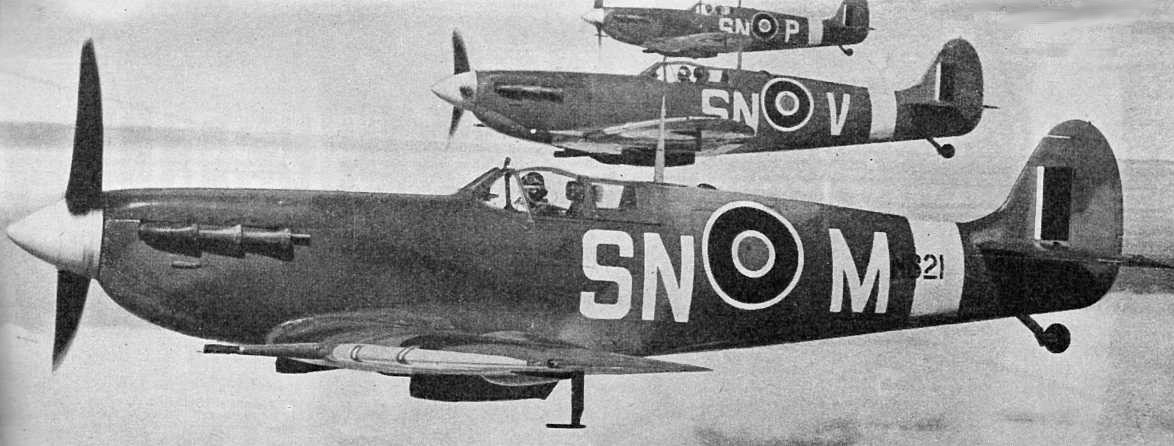
Spitfire Vbs of No 243 Squadron, shortly before the squadron was transferred to North Africa.

Spitfire, serial number R6923 of No 92 "East India" Squadron in the Spring of 1941. This aircraft was originally built as a Spitfire Mark I in August of 1940. It was later updated to Mk Vb standard in which configuration it is pictured here. It was lost in combat in June 1941.

Spitfire Mk VB floatplane, showing the larger fin with ventral extension.
At the time of the invasion of Norway, work was started on converting Mk I Spitfires to use floats designed for use with Blackburn Shark torpedo bombers and Blackburn Roc fighters. This work was stopped after the fall of France. However, when war with Japan started a new set of floats was designed to be fitted to the Spitfire MkV with a view to using them in the Pacific and Indian Ocean. Three floatplanes were built and they had modified tails and tropical filters (the first of the floatplanes flew for a time with the large tropical "beard" type filter but this was replaced by the much smaller "Aboukir" type). All three floatplanes went to Egypt and it was planned for them to operate in the Eastern Mediterranean. In the event, they only operated from the Great Bitter Lake in Egypt. Max speed 324mph at 19,500 ft. Service ceiling 33,400 ft. A single Mk IX was later also fitted with floats.
SPITFIRE Mk VI

A Spitfire Mk VI. You can see the intake for the "Marshall blower" air pressurisation intake below the exhaust on the nose. The 3-stack exhaust identifies it as a Mk VI. This Mk VI served with 616 Squadron.
Developed to intercept high-flying German reconnaissance aircraft, the Spitfire VI was designed for combat at extreme altitude. The cockpit was pressurised, with a double-glazed hood to stop misting, and the wings extended to end in pointed wingtips, giving greater lift in the thin air. A Merlin 47 engine of 1,415 hp was fitted, driving a four-bladed propeller. An extra air scoop, on the starboard side of the engine, fed a "Marshall blower" to provide the air to pressurise the cabin. The Mk VI was produced with the "B" armament of two cannons and four machine guns. The VI had a ceiling of 40,000 feet. Only 97 mark VIs were produced, they started off being built as Mk Vs but were picked off the production line to be converted to the Mk VI standard, meaning their registration numbers do not run consecutively. They were not a great success, not having the performance at altitude of the Mk VII, Mk VIII or Mk IX, and were quickly relegated to second-line duties when the Mk VII became available. Some were then fitted with "normal" or even "clipped" wings.
SPITFIRE PR Mk VI

Spitfire X4492 is described as a PR Mk IV on some websites. Yet this photograph clearly shows the fuel blisters under the wing that identify it as a PR Mk VI (redesignated from a PR IF). Note the blisters on the cockpit canopy, the streamlined windscreen without armoured glass and the deep nose to house the large oil tank needed for long missions. X4494 survived the war and ended up in Canada, where it was used to track and photograph a total eclipse of the sun on the 9th of July 1945.
Redesignation of the PR IF (see Mk I PR conversions section). Long-range, photo-recce version with no armament. Extra fuel was carried in two blisters under the wings and a small tank under the pilot's seat. A larger oil tank was fitted in a blunter nose. The canopy had blisters to allow the pilot a better view. Two vertical and one oblique cameras could be carried according to the mission to be carried out. Under optimum conditions, a PR MK VI could reach Berlin and return. It was replaced by the PR Mk IV, which had an even longer range. Only 15 PR Mk VIs were produced.
SPITFIRE Mk VII

A Spitfire Mk VII, showing the extended wingtips and the extra air intake for the Marshall blower on the side of the engine, below the 6-stack exhaust.
Another high-altitude fighter version. It was thought that the Germans would use high-altitude bombers to strike at Britain, unhindered by Fighter Command`s current equipment. The development of the Mk VI and then the VII was very much an insurance policy against such a development. The VII had the Merlin 61, 64 or 71 engine, with two-stage supercharger giving 1,660 hp (Merlin 61). The two-stage supercharger revolutionised the performance of the Spitfire at altitude. Previous Merlin`s performance had died away above 20,000 feet. The new Merlins astounded pilots by their ability to keep on going up and up! The VII kept the extended wing-tips and pressurized cabin of the VI, along with the air scoop on the starboard side of the engine. It added a retractable tail-wheel and many had a pointed rudder. Small leading-edge fuel tanks increased range. Armament was of the "B" type; two cannons and four machine guns. The new Merlin introduced two equal-sized radiators, one under each wing. Previous Spitfires had an asymmetrical arrangement with radiators of unequal size. The VII could reach 44,000 feet and could climb much faster than previous Spitfires. 140 Mk VII Spitfires were produced. When the risk of high-altitude attacks on Britain had diminished, many of the Mk VII Spitfires had their extended wingtips changed for "normal" rounded tips and they flew bomber escort and even ground-attack missions where their extended range came in very handy.
SPITFIRE PR VII

Low-level photo-reconnaissance Spitfire PR VII (redesignated from PR IG) in the pale pink colour scheme that proved good at hiding the aircraft when flying under low cloud. Note the blisters on the cockpit canopy and the blanked-off camera port next to the fuselage roundel. The sideways-looking camera could be fitted to point to either side of the fuselage, depending on the anticipated approach to the target.
Redesignation of the photo-recce Spitfire PR IG (see the PR Mk I conversions section). Used for low-altitude reconnaissance, Up to three cameras could be fitted in the fuselage, two vertical and one pointing to the side. The P.R.VII had no fuel tanks in the wings, meaning the armament of eight machine guns could be retained. The canopy had teardrop-shaped "blisters" on both sides to give a wider range of vision. Unlike most PR versions, the front windscreen was fitted with armoured glass. Radio equipment was usually not fitted. Some sources claim the first few conversions were from Mk I Spitfires, while others say they were all converted from Mk Vs. There seem to have been 45 PR Mk VIIs produced. Four conversions were fitted with the Merlin 32 engine, only had 4 machine guns fitted and had the blister canopy replaced with a standard type, to become PR Mk XIIIs.
SPITFIRE VIII

Spitfire Mk VIIIs in the Far East. Note the pointed tail and retracted tailwheel.

A Spitfire Mk VIII with extended wingtips for high-altitude performance.
The VIII was very much like the Mk VII but without a pressurised cockpit. It was a properly engineered airframe to mount the new two-stage Merlin engine in. It had a retractable tailwheel, pointed rudder and a neat tropical filter, which did not impede performance. The VIII came in three versions:- The F Mk VIII was the normal fighter version. The LF Mk VIII was a low-altitude version with a Merlin 66 engine and the HF Mk VIII was optimised for high altitude with extended wingtips and a Merlin 70 engine. The VIII was perhaps the nicest version of the Spit to fly. However, production was slow to start and most went to the Middle or Far East. The need to get Spitfires with the new engines into production and out to the squadrons as fast as possible to counter the "Focke-Wulf" scourge meant that priority was given to the easier-to-produce Mk IX. The VIII had an armament of two cannons and four machine guns. Production of the VIII was 1,658 airframes. A small number of Mk VIIIs were fitted with the Merlin 63 "Special" engine and contra-props for test purposes.
SPITFIRE Mk IX

Mark IX wearing "D-Day stripes" and the colours of a Free french Squadron.

Spitfire LF IX MK356, pictured at Shuttleworth in 2018. Sadly it crashed in 2024 and its pilot, Sqdn Ldr Mark Long, was killed .
Britain`s answer to the Focke-Wulf 190, the IX was a stop-gap project to put the new Merlin two-stage supercharged engine into a Mk V airframe. The IX was kept in production far longer than anyone imagined and formed the bulk of Fighter Command`s equipment during the middle war years. The IX came in versions for low altitude combat with clipped wings and for high altitude with extended wing-tips as well as the mass-produced standard fighter version. When first introduced, the armament was two cannons and four .303 calibre machine guns. Later, the "E" wing was introduced, with an armament of two cannons and two heavy calibre .50 machine guns that gave much better range and penetrating power than the earlier rifle calibre machine guns. At medium and high-altitude the IX was superior to the FW190, although the Focke-Wulf was still slightly faster at low altitudes and had a better rate of climb to the early Mk IXs at low to medium altitudes. Later "long-nosed" versions of the FW190 regained the edge over the Mark IX but by then even better Spitfires were waiting in the wings to regain mastery of the air. It was the Mark IX that began the process of establishing air superiority for the Allies over Europe, an air superiority extended and maintained by the long-range American Thunderbolt, Mustang and Lightning fighters. One Mk IX was fitted with floats as used on the Mk V floatplanes and had the same modifications to the tail. It was reconverted to a landplane after trials during 1944. The delays in perfecting the cabin pressurisation system of the Mk VII meant the Mk IX reached squadrons before them, and it was a specially lightened Mk IX that intercepted a high altitude Junkers 86 over England on September 12th 1942, damaging it and forcing the Germans to abandon Ju 86 flights over the UK. In all, 5,665 Mark IX Spitfires were produced. Production of the Mark IX was so huge that mention should be made of the three distinct subtypes that made up production. The F IX was the original Mk IX (sometimes called the "IXA") with Merlin 61,63 or 63 engines which took full advantage of the increased performance at height. The very early examples were conversions of Mk V airframes done by Rolls Royce which had an ugly "hump" on the engine cowling over the intercooler. The LF Mk IX (sometimes called the "IXB") used the Merlin 66 engine which had its supercharger modified to best combat the FW190 at low and medium altitudes (although it was still no slouch at high altitudes). Lastly, there was the HF Mk IX with a Merlin 70 that was tuned for best operation at high altitudes.
SPITFIRE (PR) Mk X

A Spitfire PR Mk X, showing the deep nose to accommodate the larger oil tank and the Marshall Blower intake on the side of the engine.
A high-altitude photographic reconnaissance version with the pressurized cabin, retracting tail-wheel and pointed tail of the MKVII. It had a Merlin 64 engine and normal span wing fitted with leading-edge tanks and a larger oil tank in a less pointed nose to give extra range. No armament was fitted. Various camera installations could be installed. Only 16 Mark X Spitfires were produced. One was fitted with extended wingtips. They had the intake for the Marshall Blower cabin pressurisation system on the starboard side of the nose. Operational use showed that missions flown without cabin pressurisation still had little chance of being intercepted by the Luftwaffe, so production was stopped in favour of the unpressurised Mk XI.
SPITFIRE (PR) Mk XI

Spitfire PR Mk XI PL983 as displayed at Sywell in 2024

Spitfire PR Mk XI showing the deep chin holding a larger oil tank, large Aboukir air filter and camera ports in the fuselage.
Another reconnaissance version, the XI was very similar to the X except it did not have cabin pressurization. Merlin 61,63 or 70 fitted. Tropical equipment, including the "Aboukir" air filter on the carburettor intake, was fitted as standard. 471 were produced.
SPITFIRE Mk XII

Spitfire XII, note the clipped wings and the bulge on top of the nose that covered the magnetos.

Charles E Brown's evocative photo of a Spitfire Mk XII in flight won him a place in the Annual Review of the World's Photographic Art in 1945.

Charles E Brown's evocative photo of a Spitfire Mk XII in flight won him a place in the Annual Review of the World's Photographic Art in 1945.
The Spitfire XII was a dedicated low-level interceptor and introduced the Griffon engine with 1,735 hp driving a four-bladed propeller. The Griffon made the Spitfire 3 foot longer and the nose had to have two large bulges above the exhaust ports to accommodate the cylinder blocks of the new engine. It also had a smaller central bulge on top of the nose to accommodate the magneto of the single-stage Griffon Mk III and IV engines. The XII gave the R.A.F. something that could catch the FW 190 at low level, being capable of 350 mph at sea level. All the Mark XIIs had clipped wings to give increased low-level performance. They all had pointed tail fins and an armament of two cannons and four .303 machine guns. Early examples were conversions of Mk V airframes, while later ones in the production run were based on the Mk VIII and had retracting tail-wheels. 100 mark XIIs were produced.
SPITFIRE PR Mk XIII

Photos of Spitfire Mk XIIIs are very rare. This is Spitfire L1004, which started out as a Mk I before being converted to a Mk V and was then converted into the prototype Mk XIII, in which form it is pictured here. The Mk XIII retained the old-style, 3-stack exhaust. Photo from the collection of Matthew Willis.
A tactical, low-level photographic reconnaissance aircraft, the XIIIs were mostly converted from the Mark V, although four were converted PR Mk VIIs. The conversions were done by Heston Aircraft Ltd and involved fitting a 1,620 hp Merlin 32 engine optimised for low altitude performance. Most sources say the Mk XIII had a three-bladed propeller and certainly the prototype L1004 had three blades. However, one early source (The Aeroplane Spotter magazine of 1946), listed the XIII as having a four-bladed propeller, and it should be noted that the Seafire LF Mk IIc, which had the same Merlin 32 engine, had a four-bladed propeller. With almost no photographic record of Mk IIIs (just the photo of the prototype and a couple of very blurred photos of them in flight), it is impossible to confirm if 3 or 4 blades were the norm. The XIII was only fitted with 4 machine guns. Three cameras could be carried and there was provision for a "slipper" drop-tank. A normal Spitfire canopy with an armoured windscreen was used. A total of 26 were converted (including L1004, the prototype conversion) although lots of older sources list only 18. At least 11 were transferred to the Royal Navy in 1944, where they mostly served with 718 NAS at Henstridge.
SPITFIRE Mk XIV

Spitfire F Mk XIV RB159 of 610 Sqdn. Note the larger tail unit and rudder and that the tailwheel retracts.

Spitfire Mk XIV RM693, fitted with a "slipper" fuel tank.

Spitfire Mk XIV RM693, fitted with a "slipper" fuel tank.
Just as the performance of the Merlin had been transformed by a two-stage supercharger, so the already impressive power of the Griffon engine was boosted to a staggering 2,050 hp. A five-bladed propeller had to be used to absorb this new power. The Mk XIV fuselage was based on the VIII but with a fin and rudder of larger area to improve directional stability with the new engine power. Later XIVs were fitted with "teardrop" cockpit canopies to improve vision to the rear. Like the XII, the XIV had the Griffon "bulges" on the nose but had symmetrical radiators under the wings. Whereas the XII had asymmetrical radiators like the single-stage Merlin-engined Spits. The XIV initially had the "C" wing and had an armament two cannons and four .303-inch calibre machine guns. Later production had the "E" type wing with armament of two cannons and two .50-inch calibre machine guns. The Mk XIV was the next Spitfire to be produced in quantity and took the fight to the enemy, being introduced in 1944 in time for the liberation of Europe. The XIV had the measure of the long-nosed FW190 D that appeared sometime later. However, by this time air superiority had been largely won, so the Spitfires were often free to engage ground targets. The Mk XIV could carry a 250 or 500-lb bomb under the fuselage and two 250-lb bombs under the wings. (even so, it would take a whole squadron of Spitfires to carry the bombload of a single Lancaster bomber, and over much less range). The Mk XIV was also one of the few aircraft able to catch and destroy the V1 flying bomb. The Spitfires could sometimes "tip-up" the wing of a V1 by flying alongside and putting their wing under that of the flying bomb, causing it to tumble out of control. 957 Spitfire Mk XIV aircraft were produced.
SPITFIRE Mk XVI

Restored Spitfire LF XVI.
Very much like the IX but with the American-built Packard version of the Merlin 66 known as the Merlin 266. All had the "E" type wing and were usually armed with two cannons and two .50-inch machine guns, although there was provision to fit four cannons instead. Many had teardrop cockpit canopies or extended wings. A four-bladed airscrew was fitted. 1,054 were produced. They were mostly used in the fighter-bomber role in Europe.
SPITFIRE Mk XVIII

Spitfire XVIII, TP265 was delivered to the RAF in June 1945. Note the camera "porthole" behind the cockpit.
A redesigned airframe to take the two-stage Griffon was the main feature of this type. (The Mk XIV being a quick exercise using the earlier Mk VIII airframe) The XVIIIs all had teardrop canopies and extra fuel in the wings. The first 199 were built with the provision to carry cameras and thus do photo-recce operations if called upon. The last 101 had no provision for cameras, making a total of 300 produced. The engine was a Griffon 65 driving a five-bladed propeller. The "E" type wing was used, with an armament of two 20mm calibre cannons and two .50-inch calibre machine guns. The Spitfire XVIII arrived too late to see combat in WW2, although it did see action in "Operation Firedog" in Malaya and it was a Spitfire XVIII that carried out the last RAF Spitfire combat sortie in 1951.
SPITFIRE PR Mk XIX.

Spitfire XIX: it outlasted all the other Spitfire marks in RAF service.
A high-altitude P.R. version of the Mk XIV. Designed to have cabin pressurisation, they had extra fuel tanks in the wings and curved, streamlined "Lobelle" windscreens without armoured glass protection. No armament was fitted. A number of different camera installations could be installed. The first 26 examples were built with the Griffon 65 engine and did not have cabin pressurisation or tropical equipment. The rest were built with the Griffon 66 and had cabin pressurisation as well as being equipped for service in tropical climates. All had 5 bladed propellers. It was a Mk XIX that flew the last operational Spitfire sortie for the RAF in 1954. 225 examples of this mark were produced.
SPITFIRE Mk XX
The two single-stage, Griffon-powered Spitfire Mk IV (DP845 and DP851) were renamed the Mk XX to avoid confusion with the PR Mk IV. DP851 later went on to be modified as a prototype for the F Mk 21, for which the wing was greatly strengthened although it did not have the new shape of wing eventually developed for that mark.
SPITFIRE F Mk 21 "Victor"

Spitfire F Mk 21s of 600 Squadron.


The revised wing shape: introduced by the Mk 21.
With the Mk 21, the classification of Spitfire marks swapped from Roman to Arabic numerals. The wing of the Spitfire had changed very little during the aircraft`s development. However, with the Mk 21 the elliptical wing gave way to a new one with blunted tips and changes to the flaps and ailerons. The wing was made even stronger and carried four 20mm cannons. The fuselage was redesigned and the whole airframe was heavier than previous Spitfires, meaning the undercarriage had to be made more robust. The wheels were now fully covered by undercarriage doors in flight (this had been a feature of Mitchell`s first prototype Spitfire and the prototype Mk III but was not adopted on any production Spitfire before the 21). The changes were so major that for a time it was thought best to drop the name "Spitfire" and an alternative name of "Victor" was used in some of the Air Ministry correspondence about the aircraft. The usual engine was a Griffon 61 or 64 with a five-bladed prop, although a few were fitted with the Griffon 85 with six blades in two sets of three rotating in different directions (known as a contra-rotating propeller) to use fully the 2,375 hp of the Griffon. The Mk 21 kept the normal bulged cockpit. When first introduced, the Mk 21 had bad control characteristics, these were cured by modifications to the rudder and elevators. 122 were produced. First deliveries started in September 1944 but the first squadrons did not convert to the type until late in 1945, too late to see service in WW2. It should be noted that DP851 the modified Mk IV/ Mk XX that served as the "prototype" for the Mk 21, did not have the new type of wing.
SPITFIRE F Mk 22.

The prototype Spitfire F Mk 22, PK312, shown in flight with the large "Spiteful" tail fitted.

The same Spitfire F Mk 22 in earlier configuration with a smaller tail. It has the bubble hood pushed back.
The Mk 22 was the Mk 21 but with a teardrop hood and cut-back rear fuselage. Most Mk 22s had the huge tail fin developed by Supermarine for the Spiteful interceptor; planned as the Spitfire`s successor. The cut-down rear fuselage and bubble canopy had a detrimental effect on handling with most pilots preferring the earlier Mk 21. The Mk 22 had an armament of four 20mm cannons and could carry up to three 500 Ib bombs. 272 Mk 22 Spitfires were produced. They saw only limited post-war service with front-line squadrons, most being used by Auxiliary Air Force squadrons. Twenty were sold on to the Egyptian Air Force.
SPITFIRE Mk 23 "Valiant".
Mark number assigned to a project to produce a Spitfire with a laminar flow wing and 6-cannon armament. A wing with the minimum modifications thought necessary to induce laminar flow was fitted to a single Mk VIII (JG204) but produced no worthwhile drag advantage over the normal Spitfire wing and it had bad handling qualities. The production prototype F Mk21 Spitfire (PP139) was modified with an enlarged tail and extended wingtips on an F Mk 21 style wing, to be close to the proposed Mk 23 standard, but again, no advantage in performance was forthcoming. So the Mk 23 was never produced. If it had gone into production it was planned to rename the type as the "Valiant".
SPITFIRE F Mk 24

The last production Spitfire, the 24 had the big "Spiteful" tail as standard, and a Griffon 85 engine driving a 5-bladed propeller. They could be fitted with the new Mk V short-barreled cannon that did not protrude as far ahead of the wings as the earlier Hispanos. The Mk 24 could carry the normal 3-inch British rockets but also seems to have had provision to carry up to 4 of the big "Triplex" rocket projectiles. 54 F Mk 24 Spitfires were produced. A squadron equipped with them (No 80) was rushed to Hong Kong in 1949 when the territory was threatened during the Chinese Civil War.
SPITEFUL

Supermarine Spiteful.
Supermarine's replacement for the Spitfire, the fuselage was similar in lines to the later Spitfires. It had an all-new laminar-flow wing with straight leading and trailing edges and a wide-track inward retracting undercarriage. An armament of four cannon was carried. The engine was a 2,375 hp Griffon driving a 5-bladed propeller. The Spiteful showed no large improvement in performance over the later Spitfires and the new jet technologies promised to make it obsolete, so only 2 prototypes and 17 production versions were built. In trials, a Spiteful fitted with a 2,420 hp Griffon 101 engine reached a top speed in level flight of 494 mph. The wing design of the Spiteful was later used in the Supermarine Attacker naval jet fighter.
"Aerolite" Spitfire.
In February 1941, the Air Ministry placed a contract with Aero Research Ltd, based at Duxford, to produce an experimental Spitfire fuselage made of "Aerolite", a resin-based material strengthened with flax, essentially a "plastic" Spitfire. Later, a second fuselage was ordered. Ironically, one of the machines used to produce the Aerolite had been made in Germany just prior to the war. Aero Research were keen to move to the full production of plastic Spitfires but the Air Ministry had no intention of doing so, seeing it as purely a research project in case of a shortage of aluminium alloys. The two plastic fuselages were moved to Farnborough where they underwent prolonged testing, including being left in the open for 2½ years to see the effect of weathering.
Two-seat training and leisure flight Spitfires (T8 and T9).

ML407, the "Grace" Spitfire at Sywell.

More representative of a "T9" Spitfire, with a bulbous second cockpit, is MJ627.
During the war, a single Mk V Spitfire was converted into a two-seater by No 261 Squadron in Italy, it did not have dual controls and was only used for communication duties. The Russians also converted at least one Mk IX with a second streamlined cockpit but it had a very restricted forward view. Directly after the war, Supermarine converted a single Mk VIII (MT818) into a two-seat trainer (called the "T8 conversion") with a stepped-up, bulbous "bubble" cockpit, with the aim of it being adopted by the RAF, but the project was rejected and the single Mk VIII trainer went into civilian ownership, it is now used for pleasure flights based at Biggin Hill. In the very late 1940s, the availability of many cheap, surplus Spitfires prompted Vickers to buy some Mk IX Spitfires and convert them into two-seat trainers for sale to foreign air forces. Called the "T9 conversion", a total of 20 were built. They were sold to the Netherlands, India and Ireland. Some of these are now used for giving air-experience pleasure flights, enabling people to experience the magic of flying in a Spitfire. Perhaps the most famous example is ML407, the "Grace" Spitfire based at Sywell. It has been adapted to have a more streamlined second cockpit, rather than the bulbous bubble cockpit used in the T9 conversion. Other single-seat Spitfires have been restored or rebuilt into twin-seaters to meet the growing demand for a "Spitfire Experience".
NAVAL SPITFIRES AND SEAFIRES.
"Hooked" Spitfire.
The RAF loaned the Royal Navy 110 Spitfire Mk Va and Vbs and three Mk IIbs for training purposes to prepare for the adoption of a proper conversion of the Spitfire for carrier operations. 59 of the Spitfire MK Vs and all three of the MK IIbs were fitted with arrestor hooks for training and known as "Hooked" Spitfires.
SEAFIRE Mk I B

Seafire Mk Ib pictured as originally built as a Spitfire Mk Vb with registration BL676. When converted to a Seafire it was given the registration MB328. It retained the large Vokes filter under the nose.

Seafire Ib

This photo shows that not all Seafire Ibs had a tropical filter under the nose. NX957, nearest the camera, was built as a Spitfire Vb with an original registration of AD368. It was converted to a Seafire Ib by the Cunliffe-Owen Aircraft Company in 1943.

Seafire Ib

This photo shows that not all Seafire Ibs had a tropical filter under the nose. NX957, nearest the camera, was built as a Spitfire Vb with an original registration of AD368. It was converted to a Seafire Ib by the Cunliffe-Owen Aircraft Company in 1943.
A naval conversion of the Spitfire Vb. Fitted with arrestor hooks, homing beacon receivers and slinging points, they were intended for combat use. All 166 of the Seafire IBs were conversions of existing Spitfire Vbs, many had the tropical "Vokes" filter on the carburettor intake under the nose. They did not have folding wings and therefore took up a lot of space in the hangars of aircraft carriers, restricting the number that could be carried. Conversions of MK Vb Spitfires to be Seafire Ibs continued even after production of the the Seafire Mk II C had started.
SEAFIRE F Mk II C and L Mk II

Seafire IIb MB189, 880 Naval Air Squadron (NAS) on HMS Indomitable, 1942.

Seafire L MkIIC, MB156
Based on the Spitfire Mk V, this time the Spitfire Vb with the universal wing able to take either the usual 2 cannon and 4 m-guns or four cannon (the latter option never fitted) and provision for a bomb under each wing. All the Seafire F Mk IIs were produced as new and were not conversions of existing aircraft. They still had non-folding wings. A more powerful Merlin 32 engine driving a four-bladed propeller started to be fitted from November 1942, the designation for a Seafire so equipped being L Mk IIC. In due course, all remaining Mk IICs were converted to this configuration. It was Seafire Mk IICs which provided the majority of air cover for the "Torch" landings in West Africa (some Seafire IBs were also used). In all, 370 Mk IICs were produced. Some were modified to carry two cameras for the photo-recce role, in which form they were known as Mk L R IIC. Twenty-six of the later Seafire F Mk IIIs off the Westland production line were built with non-folding wings in which form they were known as "Hybrid" MK L IICs.
SEAFIRE F Mk III and L Mk III.

The prototype Seafire III (MA970) with wings folded. This prototype was modified from a Seafire MK IIc and had a three-stack bank of exhausts. Most Spitfire IIIs had the 6-stack type.

Seafire MK III on the deck of HMS Implacable in the Far East. It has an American 89-gallon drop tank under the fuselage. The use of these tanks (traded for Scotch whisky) greatly extended the endurance of the Seafires.

Seafire MK III on the deck of HMS Implacable in the Far East. It has an American 89-gallon drop tank under the fuselage. The use of these tanks (traded for Scotch whisky) greatly extended the endurance of the Seafires.
Another aircraft broadly similar to the Mk V Spitfire, but with a Merlin 55 engine driving a four-bladed propeller and folding wings. The wing folded upwards just inboard of the cannon and the tips folded down giving a "Z" configuration. When fitted with the Merlin 55M engine the designation became L Mk III. The Mk F Mk III was the most numerous Seafire with 1,220 produced. They saw widespread service, in the Atlantic, Mediterranean, Indian Ocean and Pacific. The 250 Mk IIIs produced by the Cunliffe-Owen company in Southampton had the benefit of being completely flush-riveted, giving less drag and a slightly higher performance.
SEAFIRE Mk XV
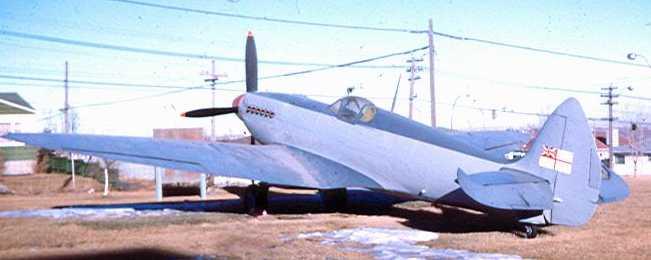
Royal Canadian Navy Seafire XV photographed by B25B17

Seafire Mk XV landing, showing the "stinger" style arrestor hook deployed.
This had the single stage Griffon engine in a basically Seafire L Mk III airframe but with wing-root fuel tanks, retracting tailwheel and larger tail of the Spitfire VIII. It had folding wings and the two cannons, four machine gun armament. Although it only had a single-stage Griffon it had symmetrical underwing radiators. The arrester hook was often of the "stinger" type, whereas previous marks had used a "V" frame hook. The XV could carry a 500lb bomb and the last 50 had the teardrop hood. 390 produced. This first Griffon-engined Seafire was introduced in May 1945 but did not see combat in WW2.
SEAFIRE Mk XVII (or F Mk 17).

The first Seafire Mk XVII, NS493, was modified from a Mk XV, given a teardrop canopy and cut-down rear fuselage.
The XVII (also called the F Mk 17) was very similar to the XV except that the engine was modified to give extra power for take-off. Like the XV, it had symmetrical underwing radiators even though it had a single-stage engine. The sting tail hook and teardrop hood were made standard. The preferred armament was now four 20mm cannon. Some were completed as reconnaissance aircraft, in which guise they were called FR MK17. Late XVII models featured a long-stroke undercarriage that greatly assisted carrier landings and an increased range due to a fuel tank behind the pilot and "plumbing" for wing-mounted "slipper" fuel tanks. 232 produced.
SEAFIRE Mk XVIII (or FR Mk 18)
The designation given to a planned development of the XVII fitted with either a Griffon 36 or 37 engine driving a five-bladed propeller. It was apparently to be a dedicated fighter-reconnaissance type with the cannon armament deleted (although the four machine guns were to be retained) and additional fuel. The project was dropped and no prototype was completed.
SEAFIRE FR Mk 45.

Seafire FR Mk 45 LA443 was delivered in June of 1945.
All previous Seafires had single-stage engines, fine for low-altitude work and the defence of the fleet from all but high-altitude bombers, which would have found moving warships an impossible target anyway. These Seafires were also well suited to supporting seaborne landings with low-altitude bombing and strafing runs. However, now it was time to take the war to the Japanese home islands and to fight a battle for air supremacy over those islands. Now there was a need to get a really high-performance, high-altitude fighter to the British task forces. The Seafire 45 was the Spitfire 21 in naval guise with the two-stage Griffon engine. The new type 21 wing was kept and did not fold, and the type 45 had the normal bulged canopy. The armament was four cannon. Some were fitted with contra-rotating propellers. But it seems these were mostly used for unmanned tests. They were launched by rocket catapult to see what happened to contra-props when crashed into the netting barriers used on British aircraft carriers. Production: 50. The Seafire 45 arrived too late to see wartime service and was used for second-line duties. It never saw use by an operational squadron.
SEAFIRE FR Mk 46.

Seafire FR Mk 46 LA542. It was used for the testing of drop-tanks and rocket projectiles.
The same as the 45, except it now had the teardrop cockpit canopy, the big "Spiteful" tail and a contra-rotating propeller. Fitted with cameras it was known as the FR 46. Initially ordered as part of the Seafire 45 production run with follow-on registration letters it was allocated its own type number but only 24 were built. Like the earlier Seafire 45, it did not see use by front-line carrier-based squadrons, being used for trial purposes and by RNVR squadrons in the UK.
SEAFIRE FR Mk 47.

The Mk 47 was the only mark of Griffon-powered Seafire with folding wings. Note the contra-rotating propellers, outer undercarriage doors and stinger arrestor hook. This first example was built with the "traditional" Spitfire style of carburettor air intake under the nose. Most Mk 47s had the intake in a "chin" directly behind and underneath the propellers.

A more representative Seafire FR Mk 47. Notice the deeper nose holding the "chin" air inlet under the propeller. Also, note the large "Spiteful" tail.

Seafire FR 47, fitted with underwing "blister" fuel tanks. This particular Seafire, VP463, spent much of its time doing armament trials.

Seafire FR 47, fitted with underwing "blister" fuel tanks. This particular Seafire, VP463, spent much of its time doing armament trials.
After the rush to get the 45 and 46 to the Fleet, the 47 was the proper solution to the needs of an invasion of Japan. The Seafire 47 had folding wings operated by hydraulics and the big Griffon 87 or 88 (2,375 hp) was fitted with contra-rotating propellers. Again there was a camera-equipped FR Mk 47 version. The armament was four 20mm cannon. Production: 140. It was the Seafire 47 that saw service in the Korean War.
SEAFANG.
SEAFANG.

Supermarine Seafang
The Seafang was the Supermarine Spiteful in naval form. An order for 150 Seafangs was placed but only 10 production aircraft had been delivered when the programme was cancelled. The powerplant was a Griffon 89 engine driving a contra-prop although the initial batch used the Griffon 69 and a normal five-bladed airscrew. The armament was four short-barreled Mk V 20mm cannon. Production: 10.
Spitfire Recognition Points
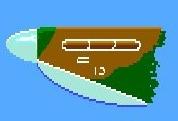
The 3 stack engine exhaust seen on the Spitfire Mks I, II, most Vs, VI and XIII. Also Seafire Mk I, most Seafire Mk IIs and the prototype and maybe a few production Seafire Mk IIIs.

The 6 stack engine exhausts of the later Merlin engined Spitfire Mks VII, VIII, IX, X, XI or XVI. Some Mk Vs also had it (usually associated with the LF Mk V). Also a few Mk II Seafires and most Seafire Mk IIIs and all later Seafires.

The "Griffon bulges" above the 6 exhaust stacks of an aircraft with a Griffon engine such as the MK XII, XIV, XVIII, XIX, 21, 22 or 24. The MkXII also had a small central bulge on top of the nose covering the magneto unit. The Griffon bulges were also a feature of all Seafires from the Mk XV onward.
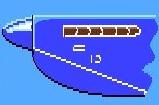
The deep chin to accommodate a big oil tank for the long-range photo reconnaissance Spitfires such as the PR Mk IV, VI, X and XI.

The rounded tail used on the early Spitfires, Mk I, II, V, VI and most Mk IXs

The more pointed rudder of the later Spitfires, first used on the Mk VII.

A tail unit of larger area was introduced on the Mk XIV.

The big fin used on the Mk24 and some late Mk 22s.

The asymmetric layout of the radiator and oil cooler under the wings shows it has a single-stage Merlin engine. The semicircular oil cooler opening limits it to be either a Mk I or Mk II.

From the Mk V the oil cooler had a circular opening. An aircraft with this configuration could be a V, VI or XIII or Seafire I, II or III.
If it also had the "Griffon bulges", and additional central magneto bulge, it would be a single stage Griffon engined MK XII.

The symmetrical radiators under the wings shows this to be a two-stage Merlin engined Spitfire, a Mk VII, VIII, IX, X, XI, or XVI.
If it had "Griffon bulges" it would be a two-stage Griffon engined XIV, XVIII, XIX, 21, 22 or 24 or Seafire Mk XV onwards.
WINGS
You'll see Spitfire marks identified with a further letter that indicated what type of wing they were fitted with
"A" Wing - The original wing used on the Mk I Spitfire, mounting 4 rifle-calibre .303 Browning machine guns in each wing (8 in all).
Used on the Mk I, Mk II and some early Mk V Spitfires.
"B" Wing - In 1940 a batch of Mk I Spitfires were produced with just a single 20mm cannon in each wing. They had no provision for machine guns, although the ammunition hatches for the two outboard machine guns were retained. They were unsuccessful, suffering many stoppages and only having 5 seconds of firing time. Improvements to the cannon improved the stoppage rate and a new wing with a cannon in each, but retaining the two outer machine guns, was evolved. It had small blisters set back on the wing and offset slightly from the cannon, to cover the cannon's drum magazine. This was known as the B wing. It was retrofitted to some Mk I Spitfires and a little over a quarter of Mk II Spitfires produced had the B wing. It was the wing fitted to the Spitfire Mk VI and was widely used on the Mk V Spitfire until the introduction of the later C wing.
"C" Wing - The "Universal" wing was originally developed for the abortive Mk III Spitfire. Each wing had mountings for two 20mm cannons and two rifle-calibre Browning machine guns. The most widely-used standard armament was a single cannon and two machine guns. The empty "stump" for the second cannon would be outboard of the first. The wing was designed for the cannons to have belt-feed, doubling the ammunition for each cannon and hence doubling firing time to 10 seconds for the cannons. To accommodate the cannon ammunition belts the inboard machine gun was moved out slightly. The wing still needed a blister, but rather than covering an ammunition drum it covered the belt-feed mechanism and was therefore in line with the cannon. Many C wings had a large blister, intended to cover both cannons if they were fitted. Other C wings had a smaller blister over the one cannon. The C wing did away with the retractable landing light under the port wing that had been a feature of the earlier wing types, this stopped the Spitfires fitted with the C wing from being used as night fighters. The C wing had the roof of the wheel wells strengthened so they did not need strengthening with external strakes, something that had to be done with the A and B wings after excessive wear. The C wing was introduced about halfway through the Mk V production run and would go on to be used on the Mk VII, Mk VIII, Mk IX, Mk XII and early XIV. It was also used on the Seafire Mk II. The folding wing of the Seafire Mk III and XV was also based on the C wing.
"D" Wing - The wing with armament removed and the leading edge used as a fuel tank on photo-reconnaissance Spitfires like the Mk X and Mk XI. Most publications about the Spitfire don't bother with specifying the D suffix because there is no need to differentiate different wing types on these marks of Spitfire.
"E" Wing - Introduced later, this wing did away with the rifle-calibre machine guns altogether. It had provision for either two cannons in each wing or a cannon and an American, large-caliber .50-inch Browning machine gun. It was the cannon and .50 calibre machine gun that was used most. The cannon was usually fitted outboard of the machine gun, meaning the "stump" of the machine gun opening was inboard of the cannon, the opposite to the C wing and a prominent recognition feature for telling the difference between a C and E wing. The E Wing was used on the late production Mk IX and late Mk XIV and all Mk XVIII Spitfires.
"TYPE 21" Wing - This redesigned wing was introduced on the Spitfire Mk 21 and used on the later Mk 22 and Mk 24 Spitfires and Mk 45, 46 and 47 Seafires. It had different elliptical profiles for the leading and trailing edges with slanted wingtips. Armament was now two 20 mm cannons in each wing, each with its own blister over the feed mechanism. There were prominent "lumps" over the undercarriage wheel wells. Some Mk 24 Spitfires and Mk 47 Seafires had the Mk V version of the Hispano cannon fitted, which did not protrude so far ahead of the wing.
SPITFIRE WING EVOLUTION (GIF ANIMATION)

Spitfire wing variations
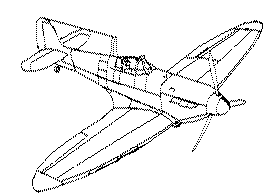
The classic elliptical wing of the Spitfire.
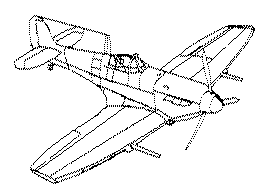
Low-altitude Spitfires had clipped wings to attain higher speeds and increase the rate of roll.

High-altitude Spitfires had extended wing tips for greater lift and better control at height.
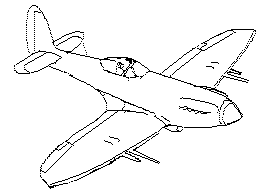
Late model Spitfires and Seafires ( Spitfire Mk 21 and Seafire 45 onwards) had a redesigned wing shape.

Spitfire with "clipped" C wing, optimised for low-level operations.
Cockpit Evolution

The early MkI cockpit with no bullet proof glass in the front windscreen. Many photo recce spitfires also had unarmoured windscreens, but with a curved, streamlined front.

The standard Spitfire canopy with armoured glass in the front windscreen, bulged sliding hood and rear-view mirror.

The teardrop cockpit used on later Spitfires

The early MkI cockpit with no bullet proof glass in the front windscreen. Many photo recce spitfires also had unarmoured windscreens, but with a curved, streamlined front.

The standard Spitfire canopy with armoured glass in the front windscreen, bulged sliding hood and rear-view mirror.

The teardrop cockpit used on later Spitfires

Showing how hard it can be to identify Spitfires is this photo of Mark V AB910. This Spitfire was built as a Vb. It saw service in both the air battle over Dieppe in1942 and on D-Day in 1944. It once took off with a WAAF hanging onto its tail! It is pictured here without cannons and wearing 1940 style brown and green camouflage (albeit with anachronistic yellow wing leading edges, only adopted in 1941) to represent a Mk I for the 1969 film "Battle of Britain". At the time, it was fitted with 6-stack exhaust banks that were never used on the Mk I, Mk II or most Mk Vs. It is now flown by the RAF Battle of Britain Flight and has been fitted with the 3-stack exhaust banks and cannons, properly representative of a Mk Vb. Full details of its history at <this link>.

Another exercise in how hard it can be to identify a Spitfire is this Spitfire LF Mk XIV RW386. It has the teadrop hood used by late production Mk XIVs. However, it has been fitted with a smaller, Spitfire Mk VIII type fin and pointed rudder and a non-retracting tailwheel, so is not truly representative of a Mk XIV. It spent time as a static "gate guardian" for many years before being restored to flying condition.
Link to a late wartime Spitfire recognition film adapted for a US service audience. It only covers the major production marks and skips the finer details.
Link to a late wartime Spitfire recognition film adapted for a US service audience. It only covers the major production marks and skips the finer details.
